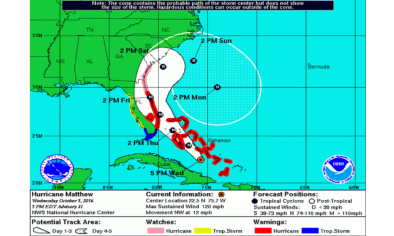How Hurricane Matthew created such a devastating deluge in the Carolinas

The rainfall from Hurricane Matthew was extreme, even by landfalling hurricane standards, inundating a large swath from Georgia, northeast through the Carolinas, and into Tidewater, Va.
...
In at least two locations — Jacksonville, Fla., and Charleston S.C. — air feeding into Hurricane Matthew contained record-high levels of TPW: 2.93 inches and 2.85 inches, respectively.
Rarely does the East Coast see values this extreme, even during the height of summer. But the waters over the western Atlantic, including the Gulf Stream, have been exceptionally warm, nearly record-breaking in their own right. This drove evaporation into high gear, rendering the overlying air sopping wet. The figure below shows a bull’s eye of 2.9 inches TPW in the very core of Matthew at 8 p.m. Friday. Most of that moisture was being converted into rain.

...
the storm also gathered vapor-laden air over a large region surrounding it. At times, the influx became concentrated into narrow channels. Like a straw dipping into the Atlantic, a deep channel of moist Atlantic air developed along the northeastern side of Matthew. As shown below, a swath of air with very high dew point temperatures (63-64° F, green shades) was drawn into Matthew as it crossed the Carolinas. The higher the dew point temperature, the more moisture in the air. These are high values considering that this analysis is at the 5,000-foot level. At the surface, dew point temperatures in the onshore moisture feed were in the low-to-mid 70s.
...
The influx of moisture, which is the product of wind speed, air density and water vapor concentration, was truly astronomical.
Related Content






